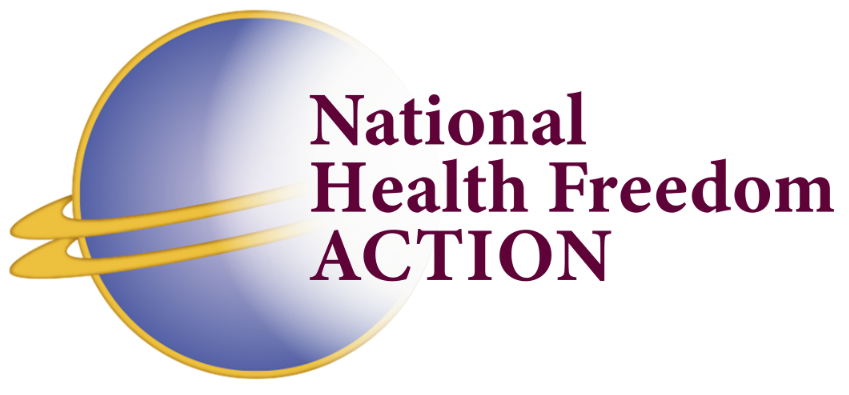
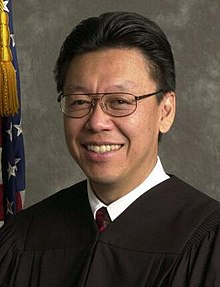
Judge Edward Chen
EPA Appeals Fluoride Trial With Claims
That the Plaintiffs All Lacked “standing”
and That The Judge Had “Commandeered”
the Trial
On September 25th of 2024 Judge Edward Chen ruled that water fluoridation poses an unreasonable risk to children’s brains. His ruling appeared to hand an ultimate victory over fluoridation to the plaintiffs as the judge ordered the EPA to make a new rule to address the neurotoxicity of fluoride.
But on July 18, 2025, the EPA attempted to turn the tables. It filed an appeal of the judge’s verdict arguing that the judge made key mistakes thus seeking, if any one of them holds water, to invalidate Judge Chen’s verdict. A three-judge appeals court will determine who is the ultimate winner: a grass-root coalition wanting to end water fluoridation or an EPA that wants to do nothing about the health hazards of water fluoridation. EPA’s appeal boldly argues that none of the plaintiffs had standing to sue, not even a pregnant woman in a fluoridated town in Kansas who, at first glance, seemed like the perfect plaintiff. And it argues that the trial court judge Edward Chen’s conduct of the trial was so erroneous that the whole should be ruled invalid.
Under Trump II, EPA goes for business as usual
EPA’s legal arguments, formulated by the Solicitor General and his staff at the US Department of Justice (DOJ), come after a nine-year legal process in which activists and non-profits seek to do what previous presidents, Trump I and Biden, had made it do: perform a risk assessment on the hazards posed by water fluoridation and halt the unsavory practice of water fluoridation. The fact that the EPA, aided by the DOJ, is appealing a judge’s ruling suggests that some portions of the Trump II administration, still supports “business as usual.”
Many Americans went to the polls last November looking for reform and an example of that is federal agencies that truly serve the people. As a presidential candidate, Robert F Kennedy Jr called for reform that included an end to “agency capture.” When Kennedy actually emerged in the Trump II presidency as Secretary of Health and Human Service (HHS), it was hoped that his spirit of reform would permeate all of the Trump II federal agencies. The hope was that Trump II would be a culture of MAHA and federal agency reform.
But now it does not appear to be entirely that way. Despite thousands of messages urging them to stand down on the appeal, EPA/DOJ did file the appeal, and some of the details suggest that the EPA is doing so with the support of the most polluting corporations that it is supposed to be regulating.
The American Chemistry Council (ACC), a trade association of big oil companies and chemical polluters, is planning to file an amicus (friend of the court) brief in support of the EPA’s appeal. ACC dislikes the Toxic Substances Control Act of 1976 (TCSA) statute, since it allows activists and critics to bring their petitions and then lawsuits against a rogue federal agency to make it do the right thing and ban toxins. It has a massive lobbying team to influence Congress and President Trump’s appointment of Lee Zeldin as administrator of the EPA also shows its deep, continued influence in Trump II. Lee Zeldin is a staunch advocate for the interests of big oil and gas and President Trump’s appointment of Zeldin has been described as a “giant gift to big oil.” So, in appealing the

Lee Zeldin, EPA Administrator
fluoride trial verdict, Lee Zeldin aligns with “big oil” as well as with “big dentistry.” On the other hand, the Centers for Disease Control (CDC), which falls within the Kennedy-led HHS, will likely be ordered to entirely stop its promotion of water fluoridation; but the EPA’ s resistance to the fluoride trial’s verdict shows a stubborn alignment with “business as usual” there in President Trump, as if nobody there had ever heard of MAHA and reform, and the appeal leaves open with the dire possibility that the EPA might prevail in its appeal of the fluoride verdict, with the verdict then being stricken.
Whose side is President Trump really on?
It is hard for President Trump to say he will “Make America Healthy Again” when EPA remains a captured agency, leaving America mired in fluoride and, truthfully, so many other toxins. An example of another bad Trump appointment is that of the Federal Communications Commission so that the FCC remains captured by the wireless industry, leaving the American people as some of the most heavily microwaved people in the world. With all of his power and sway, Donald Trump could do much more good than he has so far done. He needs to think about who’s side he is really on, and what he wants for the health and the freedom of the American people.
Does EPA’s opening brief hold water?
EPA claims none of the plaintiffs have standing – The concept of legal standing is this: do at least some of the the plaintiffs (even one!), the parties seeking a legal remedy, have sufficient connection to the policy or action (or inaction) that is being challenged. If the plaintiffs are judged as not having legal standing, then the case is to be halted and dismissed, and it will not be tried on its substance, i.e. on the allegations brought forward by the plaintiffs. That is what the EPA is seeking to do, even now at this late hour. EPA is now arguing that even a plaintiff named Jessica, a pregnant woman living in water fluoridated town of Leawood, Kansas, did not have standing in the case. At first, her situation seemed to be perfect for the case, because she was pregnant in 2020 and had her baby in that year. She and her baby were arguably at risk of future harm from water fluoridation if EPA does nothing to protect her from it. But, in a somewhat convoluted argument, EPA found out and argues that Leawood, Kansas already had some fluoride, between 0.24 and 0.4 ppm, naturally occurring in its water. EPA then goes on to argue from that, that Jessica would already be hopelessly impacted by that naturally occurring fluoride, leaving the EPA with no ability to remedy her hopelessly fluoride-toxic situation. That is, she and the others in her town are already doomed by fluoride already naturally occurring there in the water. So – presto – EPA says that Jessica had no standing and, of course, it manages to argue that no other plaintiffs, including the non-profit organizations, did either. If EPAs’ sweeping attacks on plaintiff standing hold water, the entire case is thrown out. With 200 million Americans being forced to drink and use water that is fluoridated, it seems bizarre to think that no one person and no non-profit on the list of plaintiffs would end up with standing. Judge Edward Chen ruled long ago that they had standing!
We suggest that Jessica does have standing
A rebuttal might say this: yes, naturally occurring fluoride in Leawood’s water might have some undesirable impact, but water fluoridation, which is currently imposed on Leawood, approximately doubles the dose of fluoride, making adverse fluoride impacts distinctly greater. So, an EPA rule, which might well do away with fluoridation, would have a helpful impact on the situation. Further, an EPA rule might well alert officials and the public in towns such as Leawood as to the adverse impact of exposure to fluoride in the water and such an alert could lead families and/or the town itself, to filter out naturally occurring fluoride in their water or to find other, better sources of water, that are naturally lower in fluoride. So, the EPA, through its rules and recommendations, could make a very positive impact on Jessica’s situation. We see an argument that Jessica does have legal standing to sue, and the case should be tried on its substance.
EPA also claims that Judge Chen let too much scientific evidence into the trial
Ho, ho, ho, too much? EPA/DOJ now argues that Judge Chen seriously erred by allowing evidence into the trial that was not contained in the plaintiffs’ original 2016 petition. Fluoride research, much of it US government funded, continued through 2016 and beyond and Judge Chen allowed a considerable amount of new science into evidence both during the 2020 leg of the trial and also in the 2024 second leg when the National Toxicology Program’s (NTP) “State of the Science” summary was brought into the trial. Both parties in the lawsuit claimed to want to bring the NTP’s report into evidence in hopes that the new evidence would clinch its arguments over the science. In fact, attorneys for the defendant, EPA, always insisted that such further evidence would support its contention that the science was and is too unsettled for it to do a risk assessment and then adopt a rule. But the ongoing evidence just favored the plaintiff’s case further and the judge’s decision went for the plaintiffs. Now EPA argues Judge Chen erred by allowing way too much new evidence into the trial and that was a fatal mistake in his conduct of the trial. Is EPA just being inconsistent and self-serving in now arguing that Chen let in too much evidence; it seems that way when, during the trial, EPA had always argued that further evidence was needed in order to support its views on the state of the science.
EPA also claims that Judge Chen “commandeered” the trial, allowing trial testimony and discovery to keep uncovering evidence and to have a life of its own
All would agree that the fluoride trial was long, bitter and hard-fought. The judge constantly heard objections and motions and had to rule on them. We think Judge Edward Chen should get a medal for having the strength and stamina to endure it all and to see it through to the end. And, seeing it through, Judge Chen seemed to be a model of impartiality. It seems that he didn’t want to give the EPA any reason to complain and to appeal. He bent over backwards to be fair to the EPA, granting the delay that EPA wanted in order to bring in the NTP report and allowing the EPA to attempt to find support in the “Spanish study,” which, weirdly enough, concluded that water fluoridation actually raises the IQs of children in the fluoridated community. The Spanish study, using very questionable methodology, ended up being dismissed entirely as evidence. He rolled with the punches in hearing this historically long, contentious trial. It seems to be a stretch to us for the EPA to argue now that Chen “commandeered” the entire trial in a way that fundamentally violated the TSCA statute guidelines that provide for such a trial as this one.
We’ll see. In about six to twelve months from now, the appeals court judges will hear the arguments and counter-arguments in this appeal, and then decide whose arguments are more persuasive. Many of the 200 million Americans currently under the thumb of that very coercive practice, water fluoridation, will be watching with interest.
RECENT NEWS

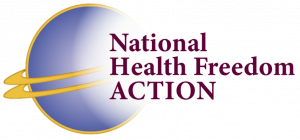
National Health Freedom Action: 2025 Year in Review
December 18, 2025
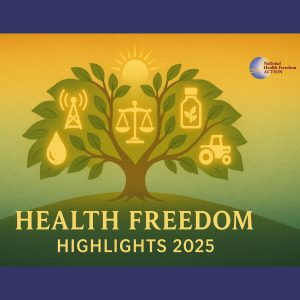
Top Health Freedom Highlights of 2025
December 11, 2025
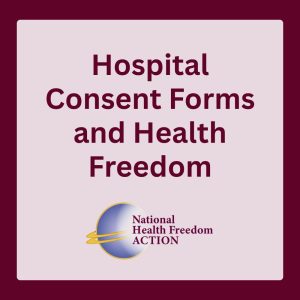
Hospital Consent Forms and Health Freedom
December 4, 2025
